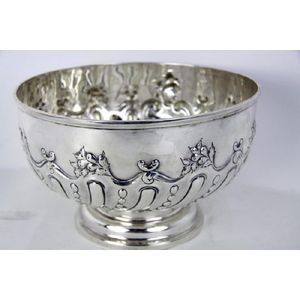Edwardian Sterling Silver Pedestal Bowl
You must be a subscriber, and be logged in to view price and dealer details.
Subscribe Now to view actual auction price for this item
When you subscribe, you have the option of setting the currency in which to display prices to $Au, $US, $NZ or Stg.
- Edwardian - The Edwardian period of English furniture and decorative arts design is named for Edward VII (1841 ? 1910) who was King of the United Kingdom and the British Dominions and Emperor of India for the brief period from 1901 until his death in 1910. It follows the Victorian period, in turn was followed by the Art Nouveau and Art Deco styles. In Australia, designs of this period are also known as being in the Federation style.
- Embossed / Repousse - Embossing, also known as repousse, is the technique of decorating metal with raised designs, by pressing or beating out the design from the reverse side of the object.It is the opposite of chasing, where the decoration is applied from the front. An embossed or repoussed object may have chasing applied to finish off the design.
- Sterling Silver - Sterling silver is a mixture of 92.5% pure silver and 7.5% of another metal, usually copper. Fine silver is 99.9% pure silver, and is relatively soft and the addition of the very small amount of copper gives the metal enough strength and hardness to be worked into jewellery, decorative and household objects.
- Hallmarks - A mark stamped on articles of precious metals in Britain, since the 14th century, certifying their purity. It derives its name from the Guild Hall of the Goldsmiths' Company, who recieved its Charter in 1327 giving it the power to assay (test the purity) and mark articles of gold and silver.
The hallmark will consist of several marks, including the:
- silver standard mark, indicating the purity of the metal. Sterling silver is .925 pure silver.
- the city mark indicating the city in which it was assayed eg London, Birmingham, York etc.
- the date mark, usually a letter of the alphabet in a particular font and case,
- a duty mark, indicating whether duty had been paid to the crown, and only in use from 1784 to 1890
The piece may include an additional mark, the maker's mark, although not forming part of the hallmark, will be located in the vicinity of the hallmarks.
Sometimes silver plated items will bear faux hallmarks, often confusing those not familiar with silver markings. - Hammered - A hammered finish on metal wares is achieved by striking the surface of the metal with a hammer to create a series of small, uniform indentations. The indentations can be made in a variety of patterns and depths. The resulting surface texture can vary from a subtle, almost imperceptible texture to a highly textured surface with a strong, pronounced pattern.
The hammered finish adds texture and visual interest to metal objects such as bowls, vases, and other decorative items. It can also be used to add grip or reduce glare on tools, weapons, and other functional metal objects.
A hammered finish can be applied to a range of metals, including copper, brass, silver, and gold.
This item has been included into following indexes:
Visually similar items

A late Victorian sterling silver pedestal rose bowl, 1898/9 London, with maker's marks for William Gibson & John Langman, retailed through Goldsmiths and Silversmiths' Company, 112 Regent St London, the embossed bowl with a deep continuous rocaille border,

A Edward VII silver bowl, maker James Dixon & Sons Ltd. Sheffield 1905, circular form with fluting and flower head chased decoration. 484grams. 10 cm high, 16 cm diameter

Antique chased sterling silver pedestal bowl, marked JD&S, Sheffield, 1903, approx 246g & 15 cm diameter

A Victorian sterling silver punch bowl. Maker C.S. Ltd., London 1897. Repousse chased sides in 'Renaissance' manner, with two large engraving cartouche on the sides, raised on a broad circular foot base. 1620gm.
